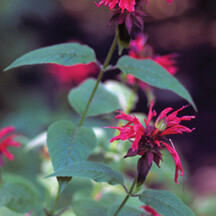Monarda didyma
(bee balm)
(bee balm)



Height: 24 – 48 inches
Spread: 200 inches
Location: Bottom, Sides
Native Status: IA
Comments & Cautions:
select cultivars with mildew resistance and provide good air circulation; some may spread less aggressively; attractive to hummingbirds
Recommended For:
 Bioretention and Rain Gardens
Bioretention and Rain Gardens
This plant prefers that the level of moisture in your soil be: Wet or Medium
This plant prefers Loam or Clay soil.
The plant DOES NOT have a salt tolerance.
Bloom and Interest Season:
Jan |
Feb |
Mar |
Apr |
May |
June |
|---|---|---|---|---|---|
 |
 |
 |
 |
 |
 |
July |
Aug |
Sept |
Oct |
Nov |
Dec |
 |
 |
 |
 |
 |
 |

Plant Form
upright, spreads by aggressive stolons to form large colonies
Foliage
bright green, toothed, and aromatic; powdery mildew can be a problem on straight species; medium-bold texture
Flowers
tubular, two-lipped flowers up to 2 inches long in dense clusters; colors include pink, purple, red, and white



